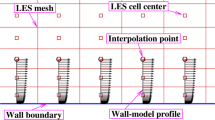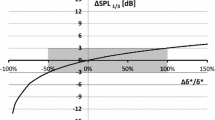Abstract
We demonstrate the effectiveness of semi-empirical Brooks, Pope and Marcolini model and hybrid large eddy simulations in calculating the blunt trailing edge wind turbine noise at higher Reynolds number conditions. The 4 million element meshes of sharp and blunt trailing edge airfoils were tested at a Reynolds number of 3.2 million and an angle of attack of 4 degrees. The predicted airfoil self-noise by the modified semi-empirical formula with a low frequency directivity function and an additional term for large thickness ratio was compared to the experiments. The sound pressure level spectra from the hybrid large eddy simulation show that the predictions agree well with experimental measurements at the same observer location in the peak frequencies of the blunt trailing edge noise and sound pressure level rates of change at lower frequencies are also similar to experiments. The modified semi-empirical formula and the hybrid large eddy simulation can be considered as promising tools for high vorticity flow problems, especially for flatback airfoils for use on large wind turbines.
Similar content being viewed by others
References
M. Barone and J. Paquette, Aeroacoustics and aerodynamic performance of a rotor with flatback airfoils, European Wind Energy Conference, Warsaw, Poland (2010).
Jr. H. Oertel, Wakes behind blunt bodies, Annual Review in Fluid Mechanics, 22 (1999) 539–64.
E. Pedersen and W. K. Persson, Perception and annoyance due to wind turbine noise? A dose response relationship, Journal of Acoustical Society of America, 116 (2004) 3460–3470.
E. Pedersen, F. van den Berg, R. Bakker and J. Bouma, Response to noise from modern wind farms in The Netherlands, Journal of Acoustical Society of America, 126 (2009) 634–643.
G. P. Van den Berg, Effects of the wind profile at night on wind turbine sound, Journal of Sound and Vibration, 277 (2004) 955–970.
R. Manceau and J. P. Bonnet, Proceedings of the 10th ERCOFTAC/IAHR/QNET-CFD workshop on refined turbulence modelling, Laboratoire d’etudes Aerodynamiques, UMR CNRS 6609, 2003, Universite’ de Poitiers, France (2003).
D. R. Chapman. Computational aerodynamics development and outlook, AIAA Journal, 17 (1979) 1293–313.
P. R. Spalart, W. H. Jou, M. Streles and S. R. Allmaras, Comments on the Feasibility of LES for Wings, and on a Hybrid RANS-LES Approach, Advances in DNS/LES, Greyden Press (1997).
K. Abe and T. Ohtsuka, An investigation of LES and hybrid LES/RANS models for predicting 3-D diffuser flow, International Journal of Heat and Fluid Flow, 31 (2010) 833–844.
S. Kubacki and E. Dick, Simulation of plane impinging jets with k − ω based hybrid RANS-LES models, International Journals of Heat and Fluid Flow, 31 (2010) 862–878.
B. Roidl, M. Meinke and W. Schroder, A zonal RANSLES method for compressible flows, Computers & Fluids, 67 (2012) 1–15.
F. Richez, I. Mary, V. Gleize and C. Basdevant, Zonal RANS-LES coupling simulation of a transitional and seperated flow around an airfoil near stall, Theoretical and Computational Fluid Dynamics, 22 (2008) 305–315.
Q. Zhang, W. Schroder and M. Meiner, A zonal RANSLES method to determine the flow over a high-lift configuration, Computers & Fluids, 39 (2010) 1241–1253.
M. Terracol, A zonal RANS-LES approach for airframe trailing-edge noise prediction, Proceedings of Euromech Colloquium 467: Turbulent Flow and Noise Generation, Marseille, France, 18–20 July (2005).
T. Kim, S. Lee, H. Kim and S. Lee, Design of low noise airfoil with high aerodynamic performance for use on small wind turbines, Science China, 53 (2010) 75–79.
T. Göçmen and B. Özerdem, Airfoil optimization for noise emission problem and aerodynamic performance criterion on small scale wind turbines, Energy, 46 (2012) 62–71.
J. E. Ffowcs Williams and D. L. Hawkings, Sound generated by turbulence and surfaces in arbitrary motion, Philosophical Transactions of Royal Society A: Mathematical, Physical & Engineering Sciences, 264(1151) (1969) 321–42.
T. F. Brooks, D. S. Pope and M. A. Marcolini, Airfoil Selfnoise and Prediction, NASA Reference Publication 1218, USA (1989).
D. E. Berg and J. R. Zayas, Aerodynamic and aeroacoustic properties of flatback airfoils, Proceedings of 46th AIAA Aerospace Sciences Meeting and Exhibit, Reno, Nevada, United States, January (2008).
P. J. Morris, L. N. Long, A. Bangalore and Q. Wang, A parallel three-dimensional computational aeroacoustics method using nonlinear disturbance equations, Journal of Computational Physics, 133(1) (1997) 56–74.
E. Labourasse and P. Sagaut, Reconstruction of turbulent fluctuations using a hybrid RANS-LES approach, Journal of Computational Physics, 182 (2002) 301–336.
F. R. Menter, Zonal two-equation k − ω turbulence models for aerodynamic flows, AIAA paper, 93-2906 (1996).
F. Mathey, D. Coklijat, J. P. Bertoglio and E. Sergent, Specification of LES inlet boundary condition using vortex method. Proceedings of 4th International Symposium on Turbulence, Heat and Mass Transfer, Antalya, Turkey, Begell House (2003).
G. R. Tabor and M. H. Baba-Ahmadi, Inlet conditions for large eddy simulation: A review, Computers & Fluids, 39 (2010) 553–67.
M. J. Lighthill, On sound generated aerodynamically I: General theory, Philosophical Transactions of Royal Society A: Mathematical, Physical & Engineering Sciences, 211 (1952) 564–87.
ANSYS/Fluent, Fluid dynamics analysis package, Fluid Dynamics International Inc. (2010).
Matlab R2010a, The Mathworks Inc. (2010).
W. K. Blake, Mechanics of flow-induced sound and vibration, Academic Press, Orlando, USA (1986).
M. Drela, XFOIL: An analysis and design system for low reynolds number airfoils, low reynolds number aerodynamics, lecture notes in engineering, Springer, New York, 54–61 (1989).
H. Blasius, Grenzschichten in Flussigkeiten mit Kleiner reibung, Z. Math Phys., 56 1–37.
P. W. Bearman and A. J. Wadcock, The interaction between a pair of circular cylinders normal to a stream. Journal of Fluid Mechanics, 61 (1973) 499–511.
C. Norberg, Effects of Reynolds number and a low-intensity freestream turbulence on the flow around a circular cylinder, Publ. 87/2, Dept. Applied Thermodynamics and Fluid Mechanics, Chalmers University of Technology, Gothenburg, Sweden (1987).
C. Norberg, An experimental investigation of the flowaround a circular cylinder: influence of aspect ratio, Journal of Fluid Mechanics, 258 (1994) 287–316.
D. Barkley and R. D. Henderson, Three-dimensional Floquet stability analysis of the wake of a circular cylinder, Journal of Fluid Mechanics, 322 (1996) 215–241.
K. Kwon and H. Choi, Control of laminar vortex shedding behind a circular cylinder, Physics of Fluids, 8 (1996) 479–486.
O. Posdziech and R. Grundmann, Numerical simulation of the flowaround an infinitely long circular cylinder in the transition regime, Theoretical and Computational Fluid Dynamics, 15 (2001) 121–141.
Author information
Authors and Affiliations
Corresponding author
Additional information
Recommended by Associate Editor Cheolung Cheong
Taehyung Kim is currently a Ph.D. candidate in the Department of Mechanical and Aerospace Engineering at Seoul National University. He received his M.S. from the same department in 2008. His B.S. is from the Mechanical Engineering at Korea Advanced Institute of Science and Technology in 2003. His research interests include airfoil self-noise generated from wind turbine blades and tonal and broadband noise caused by various propellers.
Soogab Lee is a professor in the Department of Mechanical and Aerospace Engineering at Seoul National University. He received his Ph.D. in Aeronautics and Astronautics from Stanford University in 1992. He worked as a research scientist at NASA Ames Research Center from 1992 to 1995. His research interests are in the area of aerodynamics and acoustics of rotating machines including wind turbine and helicopter systems.
Rights and permissions
About this article
Cite this article
Kim, T., Lee, S. Aeroacoustic simulations of a blunt trailing-edge wind turbine airfoil. J Mech Sci Technol 28, 1241–1249 (2014). https://doi.org/10.1007/s12206-014-0114-6
Received:
Revised:
Accepted:
Published:
Issue Date:
DOI: https://doi.org/10.1007/s12206-014-0114-6




